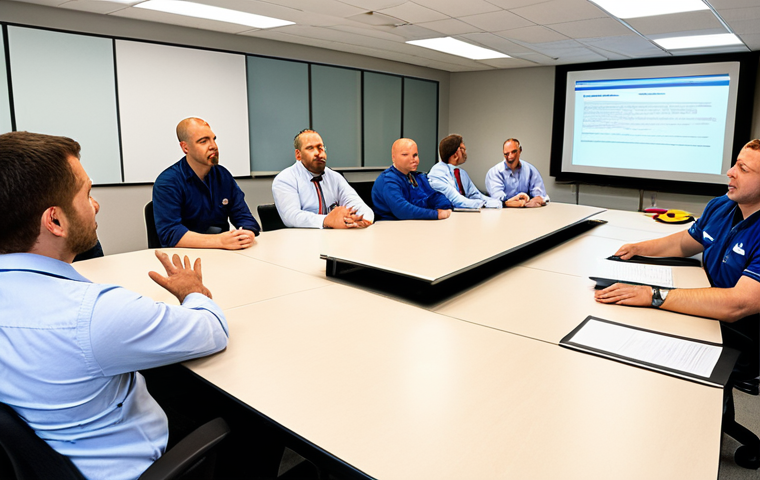Ever wondered about the difference between the Certified Safety Professional (CSP) and the Construction Health and Safety Technician (CHST)? I know I did, before diving headfirst into the world of safety certifications.
They both sound pretty similar, right? But trust me, understanding their distinct focuses and career paths is key if you’re aiming for a career in occupational safety.
It’s like knowing whether you need a hammer or a screwdriver – both tools, but drastically different purposes! The industry is constantly evolving with new tech and safety protocols too, so choosing the right certification can really set you apart.
Let’s delve deeper and get a clearer picture of which one might be the best fit for your goals. Let’s get down to brass tacks, and clarify what sets them apart!
Navigating the Occupational Safety Landscape: CSP vs. CHSTChoosing between the Certified Safety Professional (CSP) and the Construction Health and Safety Technician (CHST) can feel like being at a crossroads.
From my own journey, I can tell you that understanding the nuances of each certification is critical. Early on, I thought, “Safety is safety, right?” Wrong!
The CSP is generally seen as the gold standard, focusing on broader safety principles and management skills applicable across various industries. The CHST, on the other hand, zeroes in on the construction sector, addressing its unique hazards and safety requirements.
Think of it this way: CSP is your general practitioner, while CHST is your specialized surgeon focusing solely on construction-related ailments. I remember once working on a project where we had both CSPs and CHSTs, and the synergy was incredible.
The CSPs brought their comprehensive knowledge, while the CHSTs provided invaluable insights into the specific challenges of the construction site.
Understanding the Core Focus

The CSP is geared towards individuals who manage, administer, and advise on safety programs. It covers a wide range of topics, including risk management, hazard analysis, and safety management systems.
The CHST, in contrast, is tailored for those who implement and manage safety programs specifically within the construction industry. This includes knowledge of construction-related regulations, hazard recognition, and control methods unique to construction sites.
For instance, a CSP might develop a company-wide safety policy, while a CHST would ensure that policy is effectively implemented on a construction site, addressing specific hazards like fall protection and excavation safety.
When I was starting, the CSP seemed like the only way to go because of its wider application, but later, specializing with CHST helped me stand out when I transitioned to construction.
Scope of Responsibilities
CSPs often hold positions such as Safety Director, Safety Manager, or Safety Consultant, where they are responsible for developing and overseeing comprehensive safety programs.
Their role involves strategic planning, risk assessment, and ensuring compliance with regulations. CHSTs typically work as Safety Technicians, Safety Coordinators, or Site Safety Supervisors, focusing on the day-to-day safety operations on construction sites.
They conduct safety inspections, enforce safety rules, and provide safety training to workers. One memorable experience involved a CHST who identified a critical flaw in our scaffolding setup, preventing a potential accident.
That’s the kind of on-the-ground impact CHSTs can have.
Exam Preparation and Prerequisites
The CSP requires a bachelor’s degree (or an associate’s degree with additional experience) and four years of safety experience. The certification exam is rigorous, testing knowledge across a broad spectrum of safety topics.
The CHST requires at least three years of construction safety experience, and the exam focuses on construction-specific safety practices and regulations.
Preparing for these exams requires dedicated study and a solid understanding of the relevant body of knowledge. I spent months studying for my CSP, and the CHST also required focused preparation, especially on construction-specific codes and standards.
Decoding the Exam Content: What to Expect
CSP Exam Breakdown
The CSP exam tests a broad range of safety competencies, including:* Safety Management Systems
* Applied Sciences
* Risk Management
* Hazard Analysis
* Ergonomics
* Environmental Management
* Training and Education
CHST Exam Breakdown
The CHST exam focuses on construction-specific safety knowledge, including:* Construction Processes and Equipment
* Hazard Recognition and Control
* Safety Management and Training
* Regulatory Compliance
* Site Inspections and Audits
* Emergency ResponseCareer Trajectory and Advancement OpportunitiesThe CSP often serves as a stepping stone to higher-level safety management positions.
With a CSP, you might find yourself in roles that involve strategic planning, policy development, and overseeing safety programs across multiple sites or even an entire organization.
The CHST, while focused on construction, can lead to roles with increasing responsibility within the construction safety field. Experienced CHSTs can advance to positions such as Senior Safety Manager, Regional Safety Director, or even start their own safety consulting firms specializing in construction.
I’ve seen CHSTs become invaluable resources on large-scale construction projects, advising on everything from crane safety to confined space entry.
薪酬期望
Compensation varies depending on location, experience, and the specific role, but generally, CSPs tend to command higher salaries due to their broader skill set and management responsibilities.
According to recent data, the average salary for a CSP in the US ranges from $80,000 to $130,000 per year, while CHSTs typically earn between $60,000 and $100,000.
However, experienced CHSTs in high-demand areas can certainly exceed this range. I remember being surprised by the salary differences initially, but it makes sense given the scope of responsibilities.
| Feature | Certified Safety Professional (CSP) | Construction Health and Safety Technician (CHST) |
|---|---|---|
| Focus | General safety principles and management | Construction-specific safety practices |
| Target Audience | Safety managers, directors, consultants across industries | Safety technicians, coordinators, supervisors in construction |
| Prerequisites | Bachelor’s degree + 4 years experience | 3 years construction safety experience |
| Exam Content | Broad safety topics, risk management, hazard analysis | Construction processes, hazard control, regulations |
| Career Path | Safety Director, Manager, Consultant | Safety Technician, Coordinator, Supervisor |
Continuing Education and Maintaining CertificationBoth the CSP and CHST require continuing education to maintain certification. This ensures that professionals stay up-to-date with the latest safety regulations, best practices, and technological advancements.
CSPs need to recertify every five years, while CHSTs recertify every three years. Continuing education can take the form of attending conferences, taking courses, participating in webinars, or publishing articles.
I personally find conferences to be the most valuable, as they offer opportunities to network with other professionals and learn about cutting-edge safety solutions.
Recertification Requirements
For CSPs, recertification typically involves accumulating a certain number of continuing education units (CEUs) or points through professional development activities.
CHSTs also need to earn CEUs, with a focus on construction-related topics. Staying active in professional organizations and participating in industry events can also contribute to meeting recertification requirements.
The Importance of Staying Current
The field of occupational safety is constantly evolving, with new regulations, technologies, and best practices emerging regularly. Continuing education is not just a requirement for maintaining certification, but also a crucial aspect of being a competent and effective safety professional.
I’ve seen firsthand how staying current can make a significant difference in preventing accidents and improving workplace safety. Making the Right Choice for Your Career GoalsUltimately, the choice between the CSP and CHST depends on your career aspirations and the industry you want to work in.
If you’re seeking a broad-based safety certification that can open doors across various industries, the CSP is a solid choice. If you’re passionate about construction safety and want to specialize in that field, the CHST is the way to go.
Assessing Your Interests and Skills
Take some time to reflect on your interests, skills, and career goals. Are you drawn to the strategic aspects of safety management, or do you prefer the hands-on work of implementing safety programs on construction sites?
Do you enjoy problem-solving and analyzing data, or are you more comfortable working directly with people and enforcing safety rules? Answering these questions can help you determine which certification aligns best with your strengths and preferences.
Seeking Advice from Professionals
Talk to safety professionals who hold both the CSP and CHST certifications. Ask them about their experiences, the challenges they face, and the rewards of their work.
Attend safety conferences and network with professionals in the field. This can provide valuable insights and help you make an informed decision. I’ve always found the safety community to be incredibly supportive and willing to share their knowledge and expertise.
Navigating the murky waters of occupational safety certifications can feel like trying to find your way through a corn maze blindfolded. Hopefully, this breakdown gives you a clearer picture of whether the CSP or CHST is the right path for you.
Remember, both certifications are valuable and respected in their respective fields. Ultimately, the best choice is the one that aligns with your passions, skills, and career aspirations.
When I think back on my journey, it wasn’t just about passing exams, but about making a real difference in people’s lives by keeping them safe at work.
In Conclusion
Deciding between the CSP and CHST certifications is a pivotal step in your safety career. Reflect on your passions, skills, and desired work environment to make the best choice. Remember, both paths offer opportunities to make a significant impact on workplace safety and protect the well-being of workers.
Whether you’re drawn to the broad scope of the CSP or the construction-specific focus of the CHST, continuous learning and dedication are key to success. Embrace the journey, stay curious, and never stop seeking ways to enhance your expertise in the ever-evolving field of occupational safety.
Your commitment to safety not only safeguards lives but also contributes to a more productive and sustainable work environment. Pursue your certification with passion, and remember that your dedication makes a real difference in the world.
Handy Information to Know
1. The Board of Certified Safety Professionals (BCSP) offers resources like practice exams and study guides for both the CSP and CHST certifications. Check their official website for updated materials.
2. Local chapters of the American Society of Safety Professionals (ASSP) provide networking opportunities and study groups that can be invaluable for exam preparation.
3. Consider attending industry conferences and workshops to stay updated on the latest safety regulations, technologies, and best practices. Events like the National Safety Council Congress & Expo are great resources.
4. Online forums and discussion boards related to occupational safety can offer insights, advice, and support from experienced professionals preparing for the CSP or CHST exams.
5. Many community colleges and universities offer courses in occupational safety and health that can help you build the knowledge and skills needed to pass the certification exams and excel in your career.
Key Takeaways
• CSP: Ideal for those seeking a broad safety management role across various industries.
• CHST: Suited for individuals focusing on safety within the construction industry.
• Both certifications require ongoing education to stay current with industry standards.
• Salary expectations generally higher for CSPs due to broader responsibilities.
• The best choice depends on your career goals and industry preference.
Frequently Asked Questions (FAQ) 📖
Q: So, what’s the main difference between a CSP and a CHST? I’m trying to figure out which one’s a better fit for what I want to do.
A: Okay, think of it this way: a CHST (Construction Health and Safety Technician) is laser-focused on construction sites. I remember being on a job site as an intern and the CHST was all over the place, making sure everyone was following safety protocols for scaffolding, excavations, heavy machinery – the whole shebang.
It’s a very hands-on, practical role. A CSP (Certified Safety Professional), on the other hand, has a broader scope. CSPs have the knowledge and skills to go into almost any industry.
A CSP could be working in manufacturing, healthcare, or even government settings. They’re involved in more strategic planning, risk management, and overall safety program development.
So, CHST = construction specific, CSP = broader application and more strategic. If you’re dead-set on construction, CHST is your ticket. If you want flexibility, CSP gives you more options, plus it often requires a bachelor’s degree.
Q: Is one certification generally seen as “better” or more valuable than the other in the job market? I’m thinking long-term career prospects here.
A: That’s a good question. “Better” is subjective, but broadly speaking, a CSP tends to carry more weight and open more doors. I’ve seen job postings where a CSP is explicitly required for safety manager or director roles, while a CHST might be listed as a “plus” or acceptable alternative.
This is because a CSP is viewed as having a more comprehensive understanding of safety principles and management systems. Think of it as a CSP having a Master’s degree while a CHST has a solid associate’s degree.
However, in the construction sector, a CHST is highly valued and sometimes preferred for site-specific roles because of their focused expertise. Honestly, it depends on your career aspirations.
If you want to climb the corporate ladder in a large organization, a CSP is probably the way to go. But if you’re passionate about construction and want to be a top-notch safety professional in that field, a CHST can be incredibly valuable.
It’s all about aligning the cert with your goals.
Q: What kind of experience or education do I need before I can even sit for the CSP or CHST exam? I’m just starting out and trying to map out my path.
A: Alright, let’s talk about the nitty-gritty. For the CHST, you typically need a high school diploma or equivalent, plus at least three years of safety experience in construction.
Think about working as a safety assistant or technician for a few years – getting that on-the-ground experience is crucial. And before you can even sit for the CHST exam, you have to pay an application fee and demonstrate your practical work experience through an application process.
Now, the CSP is a bit more demanding. You usually need a bachelor’s degree (or an associate’s degree with additional experience), plus at least four years of safety experience.
The BCSP, which administers these certifications, requires specific types of safety-related responsibilities, so check their website. I learned the hard way that not all safety roles qualify.
It’s a bigger investment of time and money, but the long-term payoff can be worth it. So, get started early on gaining relevant work experience – that’s your golden ticket, no matter which path you choose.
📚 References
Wikipedia Encyclopedia



